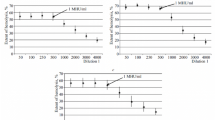Summary
By means of a fluorescein-marked anticomplement, we were able to show evidence of the presence of complement-binding elements in 1) experimentally produced and spontaneous amyloid formation in mice and 2) in a case of secondary amyloidosis in man. According to the applied control scheme, these complement-binding areas must be regarded as antigen-antibody-complexes. This is the first time that antigen-antibody-precipitates have been shown in amyloid substance. An immunobiological process is the likely basis for the amyloid formation as observed in our experiments.
Similar content being viewed by others
Literatur
Apitz, K.: Die Paraproteinosen. Virchows Arch. path. Anat. 306, 631–699 (1940).
Caesar, R.: Die Feinstruktur von Milz und Leber bei der experimentellen Amyloidose. Z. Zellforsch. 52, 653–673 (1960).
Cohen, A. S., and E. H. Calkins: Electron microscopic observations on a fibrous component in amyloid of diverse origin. Nature (Lond.) 183, 1202–1203 (1959).
Coons, A. H.: The cytology of antibody formation. Symposium. J. cell. comp. Physiol. 52, Suppl. 1, 55–67 (1958).
Coons, A. H., and M. E. Kaplan: Localisation of antigen in tissue cells. II. Improvements in a method for the detection of antigen by means of fluorescent antibody. J. exp. Med. 91, 1–30 (1950).
Coons, A. H., E. H. Leduc and J. M. Connolly: Immunhistochemical studies of antibody response in the rabbit. Ref. in Fed. Proc. 12, 438 (1953).
Fahr, E.: Fluoreszenzmikroskopische Untersuchungen über das Amyloid. Dienstbesprechung der Dtsch. Pathologen, Breslau 1944. Zbl. allg. Path. path. Anat. 83, 63 (1945).
Fragraeus, A.: The plasma cellular reaction and its relation to the formation of antibody in vitro. J. Immunol. 53, 1–13 (1948).
Friedreich, N., u. A. Kekulé: Zur Amyloidfrage. Virchows Arch. path. Anat. 16, 50–65 (1859).
Gössner, W.: erscheint in Histochemie.
Hass, G.: Studies of amyloid. II. The isolation of a polysaccharide from amyloid-bearing tissues. Arch. Path. (Chicago) 34, 92–105 (1942).
Klein, P., u. P. Burkholder: Ein Verfahren zur fluoreszenzoptischen Darstellung der Komplementbindung und seine Anwendung zur histo-immunologischen Untersuchung der experimentellen Nierenanaphylaxie. Dtsch. med. Wschr. 84, 2001–2004 (1959).
Klein, P., and P. Burkholder: Studies on the antigenic properties of complement. I. Demonstration of agglutinating antibodies against guinea pig complement fixed on sensitized erythrocytes. J. exp. Med. 111, 93–106 (1960).
Klein, P., and P. Burkholder: Studies on the antigenic properties of complement. II. Analysis of specific agglutinins against certain components of guinea pig complement fixed on sensitized sheep erythrocytes. J. exp. Med. 111, 107–118 (1960).
Letterer, E.: Studien über Art und Entstehung des Amyloids. Beitr. path. Anat. 75, 486–588 (1926).
Letterer, E.: Neue Untersuchungen über die Entstehung des Amyloids. Virchows Arch. path. Anat. 293, 34–72 (1934).
Letterer, E.: Versuche über Bedeutung des Vitamin A für Entstehung und Verhütung der Amyloidose (zugleich ein Beitrag zur Pathologie des Vitamin A). Naunyn-Schmiedeberg's Arch. exp. Path. Pharmak. 207, 500–524 (1949).
Letterer, E.: Untersuchungen über den Einfluß verschiedenartiger Ernährung auf die experimentelle Amyloidose. Zugleich ein Beitrag zur Frage der Antikörperbildung in Abhängigkeit von der Ernährung. Virchows Arch. path. Anat. 317, 1–25 (1949).
Letterer, E.: Über die geweblichen und humoralen Störungen des Eiweißstoffwechsels. IV. Franz Volhard-Gedächtnisvorlesung. Stuttgart: Friedrich-Karl Schattauer 1958.
Letterer, E.: Allgemeine Pathologie. Stuttgart: Georg Thieme 1959.
Loeschcke, H.: Vorstellungen über das Wesen von Myelin und Amyloid aufgrund von serologischen Versuchen. Beitr. path. Anat. 77, 231–239 (1927).
Mellors, R. C., and L. G. Ortega: Analytical Pathology. III. New observations of the pathogenesis of glomerulonephritis, lipid nephrosis, periarteritis nodosa, and secondary amyloidosis in man. Amer. J. Path. 32, 455–499 (1956).
Randerath, E.: Zur pathologischen Anatomie der sogenannten Amyloidnephrose. Vergleichender Beitrag zur Frage der allgemeinen Amyloidose als Paraproteinose. Virchows Arch. path. Anat. 314, 388–459 (1947).
Reiss, E., E. Mertens and E. W. Ehrich: Agglutination of bacteria by lymphoid cells in vitro. Proc. Soc. exp. Biol. (N.Y.) 74, 732–735 (1950).
Schmiedeberg, O.: Über die Beziehungen des Hyaloidins zu der Bildung der Chondroitinschwefelsäure, des Kollagens und des Amyloids im Organismus. Naunyn-Schmiedeberg's Arch. exp. Path. Pharmak. 87, 47–73 (1920).
Teilum, G.: Periodic acid-Schiff-positive reticulo-endothelial cells producing glycoprotein. Functional significance during formation of amyloid. Amer. J. Path. 32, 945–959 (1956).
Vazquez, T. T., and F. J. Dixon: Immuno-chemical analysis of amyloid by the fluorescence technique. J. exp. Med. 104, 727–736 (1956).
Vazquez, T. T., F. J. Dixon and A. L. Neil: Demonstration of specific antigen and antibody in experimentally produced amyloid. 54th Annual Meeting of the Amer. Assoc. of Pathologists and Bacteriologists, Washington, D.C., April 11th–13th, 1957. Ref. in Amer. J. Path. 33, 614 (1957).
Virchow, R.: Weitere Mitteilungen über das Vorkommen der pflanzlichen Zellulose beim Menschen. Virchows Arch. path. Anat. 6, 268–271 (1854).
Wagner, B. M.: Hypersensitivity, pp. 429–470 in: R. C. Mellors, Analytical Pathology. New York-Toronto-London: The Blakiston Division McGraw-Hill Book Co., Inc. 1957.
Waldenström, H.: Über das Entstehen und Verschwinden des Amyloids beim Menschen. Klin. Wschr. 6, 2235–2237 (1927).
Author information
Authors and Affiliations
Additional information
Herrn Prof. Dr. E. Letterer zu seinem Geburtstag am 30. 6. 60 gewidmet.
Rights and permissions
About this article
Cite this article
Vogt, A., Kochem, HG. Histo-serologische Untersuchungen mit fluoresceinmarkiertem Antikomplement. Zeitschrift für Zellforschung 52, 640–652 (1960). https://doi.org/10.1007/BF00339851
Received:
Issue Date:
DOI: https://doi.org/10.1007/BF00339851




